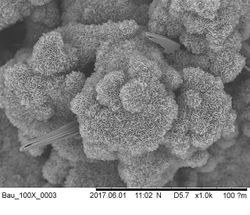LLTTI17114 - "Development of reinforced porous concrete": Difference between revisions
(Created page with "== Goal == The goal of the project is to develop reinforced porous concrete with compression strength of 1.6 MPa and density not higher than 230 kg/m<sup>3</sup> == Abstract...") |
No edit summary |
||
| Line 1: | Line 1: | ||
== Goal == | == Goal == | ||
The goal of the project is to develop reinforced porous concrete with compression strength of 1.6 MPa and density not higher than 230 kg/m<sup>3</sup> | The goal of the project is to develop reinforced porous concrete with compression strength of 1.6 MPa and density not higher than 230 kg/m<sup>3</sup> | ||
[[File:AAC tobermorite bush.jpg|250px|thumb|left| Tobermorite is the aimed for crystal phase.]] | |||
[[File:AAC Jennite 2.jpg|250px|thumb|right| Lots of Jennite make AAC weak and brittle]] | |||
== Abstract == | == Abstract == | ||
As the new regulations are forcing manufacturers to construct buildings of ever-decreasing heat exchange, there is an increasing demand for materials that provide high thermal insulation. For concrete-based materials, increased thermal insulation is achieved by increasing porocity - air pockets have much lower heat transfer capabilities than solid concrete. However, with increasing porocity (and lower density), the strentgh of the material is reduced as well. In order to maintain strenght while increasing thermal performance, reinforcements have to be introduced. The project here is attempting to introduce fiber-reinforcements to autoclaved aerated concrete. | As the new regulations are forcing manufacturers to construct buildings of ever-decreasing heat exchange, there is an increasing demand for materials that provide high thermal insulation. For concrete-based materials, increased thermal insulation is achieved by increasing porocity - air pockets have much lower heat transfer capabilities than solid concrete. However, with increasing porocity (and lower density), the strentgh of the material is reduced as well. In order to maintain strenght while increasing thermal performance, reinforcements have to be introduced. The project here is attempting to introduce fiber-reinforcements to autoclaved aerated concrete AAC). | ||
== Overview of results == | |||
There are many factors that determine the (compressve) strength of AAC. One important one is the principal crystal phase that in turn is dependent on the starting materials but also importantly on the autoclaving conditions. Tobermorite is formed during the autoclaving phase and is the main crystal phase responsible for the strength of the material. However, under less favourable conditions, other crystal phases can be formed, resulting in lowered toughness and/or strength. | |||
The reinforcing fibers need to allow cutting the AAC blocks before autoclaving and also sustain high temperature (200 <sup>o</sup>C) and pressure (12 bar) at alkaline conditions and 100% relative humidity during autoclaving. Additionally, the reinforcement should have strong interactions with the concrete materix in order to provide tension dissipation. In ideal cases, the reinforcement should support the formation of tobermorite by creating centers. | |||
== | == Project details== | ||
Partner: [https://bauroc.eu/ Bauroc AS ] | |||
Support: Enterprice Estonia, [[https://www.eas.ee/service/development-voucher/?lang=en Development Voucher]] | |||
Support: Enterprice Estonia, | |||
Duration: 01.05.2017 - 30.06.2018 | Duration: 01.05.2017 - 30.06.2018 | ||
Budget: 31,200 Eur | Budget: 31,200 Eur | ||
Latest revision as of 14:35, 7 May 2018
Goal
The goal of the project is to develop reinforced porous concrete with compression strength of 1.6 MPa and density not higher than 230 kg/m3
Abstract
As the new regulations are forcing manufacturers to construct buildings of ever-decreasing heat exchange, there is an increasing demand for materials that provide high thermal insulation. For concrete-based materials, increased thermal insulation is achieved by increasing porocity - air pockets have much lower heat transfer capabilities than solid concrete. However, with increasing porocity (and lower density), the strentgh of the material is reduced as well. In order to maintain strenght while increasing thermal performance, reinforcements have to be introduced. The project here is attempting to introduce fiber-reinforcements to autoclaved aerated concrete AAC).
Overview of results
There are many factors that determine the (compressve) strength of AAC. One important one is the principal crystal phase that in turn is dependent on the starting materials but also importantly on the autoclaving conditions. Tobermorite is formed during the autoclaving phase and is the main crystal phase responsible for the strength of the material. However, under less favourable conditions, other crystal phases can be formed, resulting in lowered toughness and/or strength.
The reinforcing fibers need to allow cutting the AAC blocks before autoclaving and also sustain high temperature (200 oC) and pressure (12 bar) at alkaline conditions and 100% relative humidity during autoclaving. Additionally, the reinforcement should have strong interactions with the concrete materix in order to provide tension dissipation. In ideal cases, the reinforcement should support the formation of tobermorite by creating centers.
Project details
Partner: Bauroc AS
Support: Enterprice Estonia, [Development Voucher]
Duration: 01.05.2017 - 30.06.2018
Budget: 31,200 Eur

